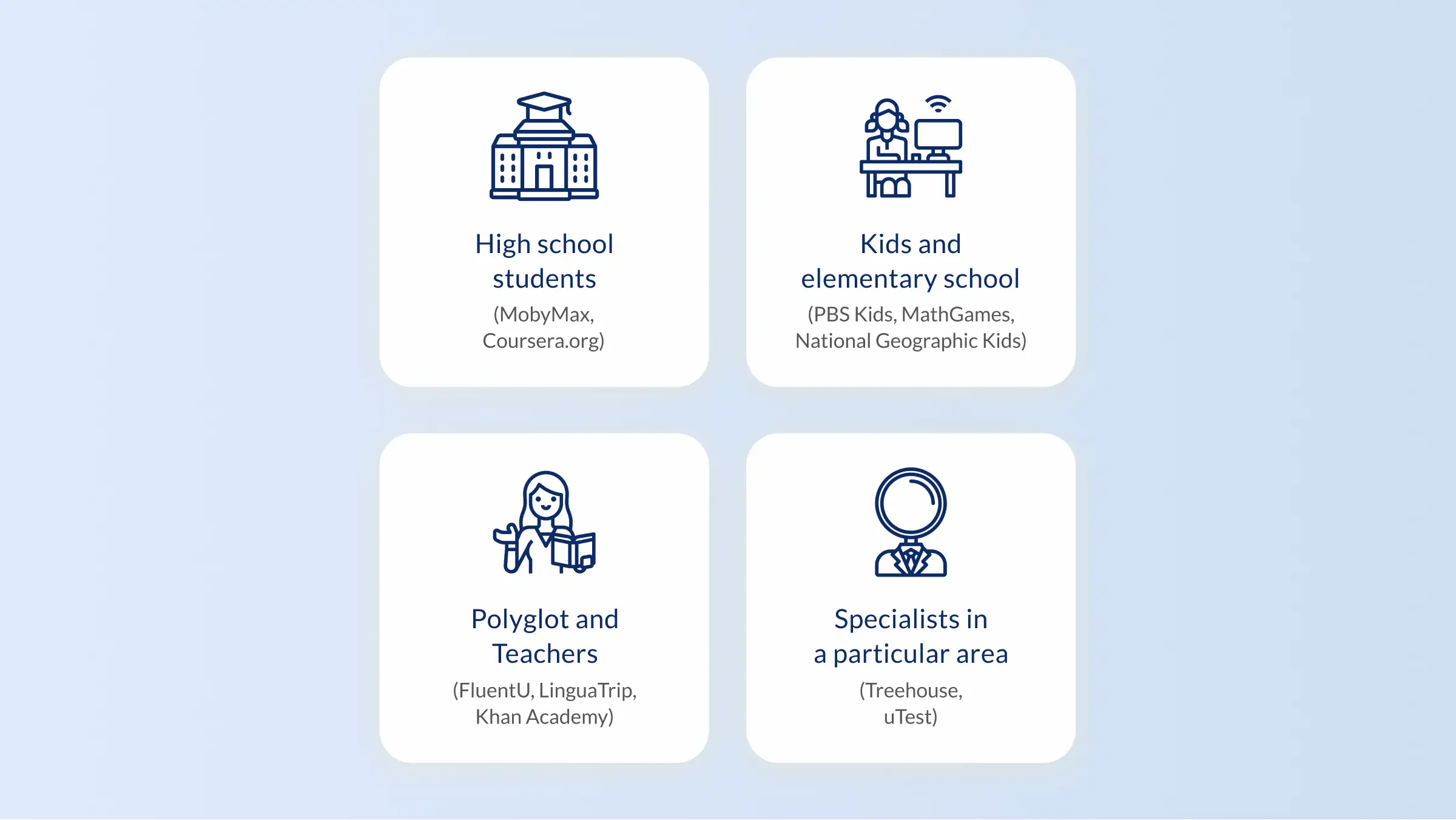Online education is swiftly gaining popularity. E-learning websites make studying more enjoyable since they often use advanced technologies like Augmented Reality (AR) or Artificial Intelligence(AI). As a result, there is high demand for this product from both users and educational service providers.
Educational Websites Types
Educational websites are usually offered by official educational institutions or online course marketplaces. Educational establishments generally include information about location, faculty, programs, and other related materials on their websites. On the other hand, online course marketplaces deliver a range of courses from various providers in fields like business, technology, and finance.
In turn, both types of websites can also be divided into subtypes depending on the learning process, such as:
- Synchronous and asynchronous learning
- Fixed and adaptive learning
- Group and individual learning
Also, e-learning sites are divided into kinds based on the target audience:
- Students
- Preschoolers
- Language learners
- Specialists in narrow fields
Educational websites by the target audience

Both types are popular due to the growing demand for online learning. Regardless of which kind of website you choose, make sure it meets your needs and the needs of your visitors. Pay attention to the site’s design to be as user-friendly and understandable as possible, providing a quality user experience. Also, protect the student data they will provide for your platform.
Below we will present the basic steps to creating a quality educational website.
How to Build an Educational Website?
An educational website is a great learning tool for students of all ages and backgrounds. However, you may need clarification about how to create an e-learning platform and succeed. There are a few basic steps to launching a successful website.
How to make the educational website
1. Conduct market research
First of all, you should determine your target audience and main competitors. This step will allow you to determine which approach to take, which products are popular, and how to differentiate your platform from your competitors.
2. Think about the domain
For your educational website to be popular, it needs to be recognizable. For example, you should choose a unique domain name that reflects the essence of your platform. After that, choosing reliable hosting and registering your domain is vital. To simplify this process, ask an experienced software provider to develop it.
3. Pay attention to the design
An educational website should be user-friendly, simple, and easy to understand. By working with a team of experienced UI/UH designers, you can create a unique design that fully reflects the idea of your project and provides an exceptional user experience.
4. Security is important
Users will be using their data when registering on your e-learning platform, so providing them with high security is essential.
5. Take care of your learning materials
For an educational website to function, you need to fill it with content. Make sure you have something to offer your customers. Also, you can partner with professional teachers and tutors to provide their services through your website.
6. Start with the MVP version
It’s best to start by developing a Minimum Viable Product, including only basic features, to launch your website faster and reduce initial investments. Then, once you get the first feedback and investment, you can expand the functionality to attract new users.
7. Choose your monetization strategy
For your educational website to be profitable, you can choose one of the following monetization models:
- Subscriptions. Offer users a monthly or annual subscription to access your educational materials.
- Pay-per-course. You can provide access to the specific content of the user’s choice for a fee.
- Donations. You can provide instructional files for free but leave users free to contribute voluntarily.
In addition, you can implement any other monetization model you see fit.
To successfully go through all these steps, you can find an app developer with experience in the education domain who will help you through all the steps and create an e-learning platform for you.
Features of a Great Education Website
Features are typically categorized as basic or advanced. Essential features typically provide basic users with what they require and anticipate. Advanced ones can be added after release, allowing you to attract more users and increase their satisfaction with your platform.
The basic features of an educational website can vary depending on its type but generally include the following:
- Registration and Login. Provide several options for users to sign up – a phone number, email, or a social media account (e.g., Facebook).
- Search. Develop a convenient search and add filters to simplify the process of finding the right course for users.
- Profile. Collect all user information on one page, including active and completed courses.
- Progress Tracker. Enable students to track their progress.
- Chat. Add the ability to chat with instructors using your educational website.
- Video calls. You can provide more effective learning by implementing a video conferencing feature.
- Feedback. Allow students to rate the courses they’ve taken and the instructors they’ve worked with.
- Admin panel. Every website needs a quality admin panel that allows you to manage the content.
In addition to the students’ block, you can add special functionality for teachers, such as grading and assigning tasks. You can also add additional features for parents that include an electronic report card. You may also create LMS to manage learning materials more straightforwardly.
Educational Website Development Cost
Calculating the final cost of creating an educational website depends on many factors, including its type and number of features and the hourly rate in the region you choose to cooperate with. Nevertheless, we have calculated the cost of creating a Coursera platform (MVP version) so that you can understand the average prices. So, if we assume an hourly rate of $50 (standard for Central and Northern Europe), an educational website costs $54000-$63000.
However, as mentioned earlier, the cost can vary from region to region. So, for example, creating a website similar to Coursera in America can cost you from $160,000 to $190,000 (at an hourly rate of $150 per hour), and in Australia – from $109,000 to $125,000 (at an hourly rate of $100 dollars an hour).
Summing up
Educational websites are rapidly gaining popularity, so creating your own e-learning platform is an excellent idea for both startups and educational institutions. Find an experienced software provider who can pick up your project at the raw idea stage, develop a great web solution for you, and get the most out of the popularity of online learning.



